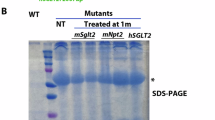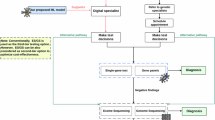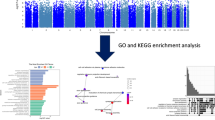Abstract
Dent’s disease is an X-linked renal tubulopathy caused by mutations mainly affecting the CLCN5 gene. Defects in the OCRL gene, which is usually mutated in patients with Lowe syndrome, have been shown to lead to a Dent-like phenotype called Dent disease 2. However, about 20% of patients with Dent’s disease carry no CLCN5/OCRL mutations. The disease’s genetic heterogeneity is accompanied by interfamilial and intrafamilial phenotypic heterogeneity. We report on a case of Dent’s disease with a very unusual phenotype (dysmorphic features, ocular abnormalities, growth delay, rickets, mild mental retardation) in which a digenic inheritance was discovered. Two different, novel disease-causing mutations were detected, both inherited from the patient’s healthy mother, that is a truncating mutation in the CLCN5 gene (A249fs*20) and a donor splice-site alteration in the OCRL gene (c.388+3A>G). The mRNA analysis of the patient’s leukocytes revealed an aberrantly spliced OCRL mRNA caused by in-frame exon 6 skipping, leading to a shorter protein, but keeping intact the central inositol 5-phosphatase domain and the C-terminal side of the ASH-RhoGAP domain. Only wild-type mRNA was observed in the mother’s leukocytes due to a completely skewed X inactivation. Our results are the first to reveal the effect of an epistatic second modifier in Dent’s disease too, which can modulate its expressivity. We surmise that the severe Dent disease 2 phenotype of our patient might be due to an addictive interaction of the mutations at two different genes.
Similar content being viewed by others
Log in or create a free account to read this content
Gain free access to this article, as well as selected content from this journal and more on nature.com
or
References
Wrong OM, Nordern AGW, Feest TG : Dent’s disease: a familial renal tubular syndrome with hypercalciuria, tubular proteinuria, rickets, nephrocalcinosis and eventual renal failure. Q J Med 1990; 77: 1086–1087, (Abstract).
Lloyd SE, Pearce SHS, Fisher SE et al: A common molecular basis for three inherited kidney stone diseases. Nature 1996; 379: 445–449.
Thakker RV : Pathogenesis of Dent’s disease and related syndromes of X-linked nephrolithiasis. Kidney Int 2000; 57: 787–793.
Gunther W, Luchow A, Cluzeaud F, Vandewalle A, Jentsch TJ : ClC-5, the chloride channel mutated in Dent’s disease, colocalizes with the proton pump in endocytotically active kidney cells. Proc Natl Acad Sci USA 1998; 95: 8075–8080.
Devuyst O, Christie PT, Courtoy PJ, Beauwens R, Thakker RV : Intra-renal and subcellular distribution of the human chloride channel, CLC-5 reveals a pathophysiological basis for Dent’s disease. Hum Mol Genet 1999; 8: 247–257.
Hara-Chikuma M, Wang Y, Guggino SE, Guggino WB, Verkman AS : Impaired acidification in early endosomes of ClC-5 deficient proximal tubule. Biochem Biophys Res Commun 2005; 329: 941–946.
Picollo A, Pusch M : Chloride/proton antiporter activity of mammalian CLC proteins ClC-4 and ClC-5. Nature 2005; 436: 420–423.
Scheel O, Zdebik AA, Lourdel S, Jentsch TJ : Voltage-dependent electrogenic chloride/proton exchange by endosomal CLC proteins. Nature 2005; 436: 424–427.
Hoopes RR, Shrimpton AE, Knohl SJ et al: Dent Disease with mutations in OCRL1. Am J Hum Genet 2005; 76: 260–267.
Shrimpton AE, Hoopes RR, Knohl SJ et al: OCRL1 mutations in Dent 2 patients suggest a mechanism for phenotypic variability. Nephron Physiol 2009; 112: p27–p36.
Cho HY, Lee BH, Choi HJ, Ha IS, Choi Y, Cheong HI : Renal manifestations of Dent disease and Lowe syndrome. Pediatr Nephrol 2008; 23: 243–249.
Sekine T, Nou K, Iyengar R et al: OCRL1 mutations in patients with Dent disease phenotype in Japan. Pediatr Nephrol 2007; 22: 975–980.
Utsch B, Bökenkamp A, Benz MR et al: Novel OCRL1 mutations in patients with the phenotype of Dent disease. Am J Kidney Dis 2006; 48: e1–e14.
Sethi SK, Ludwig M, Kabra M, Hari P, Bagga A : Vitamin A responsive night blindness in Dent's disease. Pediatr Nephrol 2009; 24: 1765–1770.
Bogdanović R, Draaken M, Toromanović A, Dordević M, Stajić N, Ludwig M : A novel CLCN5 mutation in a boy with Bartter-like syndrome and partial growth hormone deficiency. Pediatr Nephrol 2010; 25: 2363–2368.
Besbas N, Ozaltin F, Jeck N, Seyberth H, Ludwig M : CLCN5 mutation (R347X) associated with hypokalaemic metabolic alkalosis in a Turkish child: an unusual presentation of Dent's disease. Nephrol Dial Transplant 2005; 20: 1476–1479.
Sheffer-Babila S, Chandra M, Speiser PW : Growth hormone improves growth rate and preserves renal function in Dent disease. J Pediatr Endocrinol Metab 2008; 21: 279–286.
Copelovitch L, Nash MA, Kaplan BS : Hypothesis: Dent disease is an underrecognized cause of focal glomerulosclerosis. Clin J Am Soc Nephrol 2007; 2: 914–918.
Frishberg Y, Dinour D, Belostotsky R et al: Dent’s disease manifesting as focal glomerulosclerosis: Is it the tip of the iceberg? Pediatr Nephrol 2009; 24: 2369–2373.
Hichri H, Rendu J, Monnier N et al: From Lowe syndrome to Dent disease: correlations between mutations of the OCRL1 gene and clinical and biochemical phenotypes. Hum Mutat 2011; 32: 379–388.
Tosetto E, Ghiggeri GM, Emma F et al: Phenotypic and genetic heterogeneity in Dent’s disease-the results of an Italian collaborative study. Nephrol Dial Transplant 2006; 21: 2452–2463.
Addis M, Loi M, Lepiani C, Cau M, Melis MA : OCRL mutation analysis in Italian patients with Lowe syndrome. Hum Mutat 2004; 23: 524–525.
Allen RC, Zoghbi HY, Moseley AB, Rosenblatt HM, Belmont JW : Methylation of HpaII and HhaI sites near the polymorphic CAG repeat in the human androgen-receptor gene correlates with X chromosome inactivation. Am J Hum Genet 1992; 51: 1229–1239.
Tosetto E, Addis M, Caridi G et al: Locus heterogeneity of Dent’s disease: OCRL1 and TMEM27 genes in patients with no CLCN5 mutations. Pediatr Nephrol 2009; 24: 1967–1973.
Ghanekar Y, Lowe M : Signalling for secretion. Nat Cell Biol 2005; 7: 851–853.
Choudhury R, Diao A, Zhang F et al: Lowe syndrome protein OCRL1 interacts with clathrin and regulates protein trafficking between endosomes and the trans-Golgi network. Mol Biol Cell 2005; 16: 3467–3479.
Hryciw DH, Wang Y, Devuyst O, Pollock CA, Poronnik P, Guggino WB : Cofilin interacts with ClC-5 and regulates albumin uptake in proximal tubule cell lines. J Biol Chem 2003; 278: 40169–40176.
Kuhbacher A, Dambournet D, Echard A, Cossart P, Pizarro-Cerda J : The phosphatidylinositol 5-phosphatase oculocerebrorenal syndrome of Lowe protein(OCRL) controls actin dynamics during early steps of Listeria monocytogenes infection. J Biol Chem 2012; 287: 13128–13136.
Lowe M : Structure and function of the Lowe syndrome protein OCRL1. Traffic 2005; 6: 711–719.
Moulin P, Igarashi T, Van der Smissen P et al: Altered polarity and expression of H+ATPase without ultrastructural changes in kidneys of Dent's disease patients. Kidney Int 2003; 63: 1285–1295.
Grieve AG, Daniels RD, Sanchez-Heras E et al: Lowe Syndrome protein OCRL1 supports maturation of polarized epithelial cells. PLoS One 2011; 6: e24044.
Dambournet D, Machicoane M, Chesneau L et al: Rab35 GTPase and OCRL phosphatase remodel lipids and F-actin for successful cytokinesis. Nat Cell Biol 2011; 13: 981–988.
Author information
Authors and Affiliations
Corresponding author
Ethics declarations
Competing interests
The authors declare no conflict of interest.
Rights and permissions
About this article
Cite this article
Addis, M., Meloni, C., Tosetto, E. et al. An atypical Dent’s disease phenotype caused by co-inheritance of mutations at CLCN5 and OCRL genes. Eur J Hum Genet 21, 687–690 (2013). https://doi.org/10.1038/ejhg.2012.225
Received:
Revised:
Accepted:
Published:
Issue date:
DOI: https://doi.org/10.1038/ejhg.2012.225
Keywords
This article is cited by
-
Prenatal diagnosis of dent disease type I with a nonsense pathogenic variant in CLCN5: a case study
BMC Medical Genomics (2024)
-
A case of Dent disease type 2 with large deletion of OCRL diagnosed after close examination of a school urinary test
CEN Case Reports (2022)
-
Dent disease: classification, heterogeneity and diagnosis
World Journal of Pediatrics (2021)
-
Genetics and phenotypic heterogeneity of Dent disease: the dark side of the moon
Human Genetics (2021)
-
Identification and functional characterization of a hemizygous novel intronic variant in OCRL gene causes Lowe syndrome
Clinical and Experimental Nephrology (2020)



